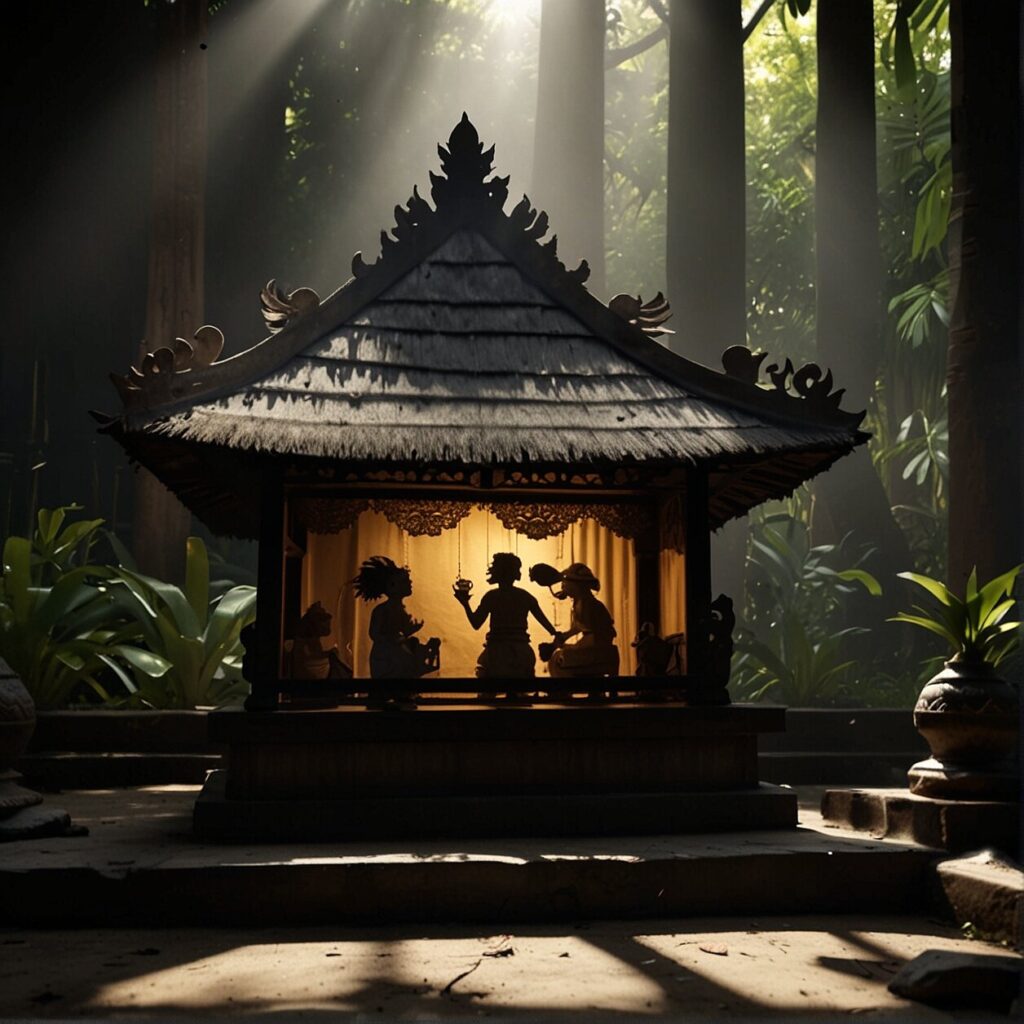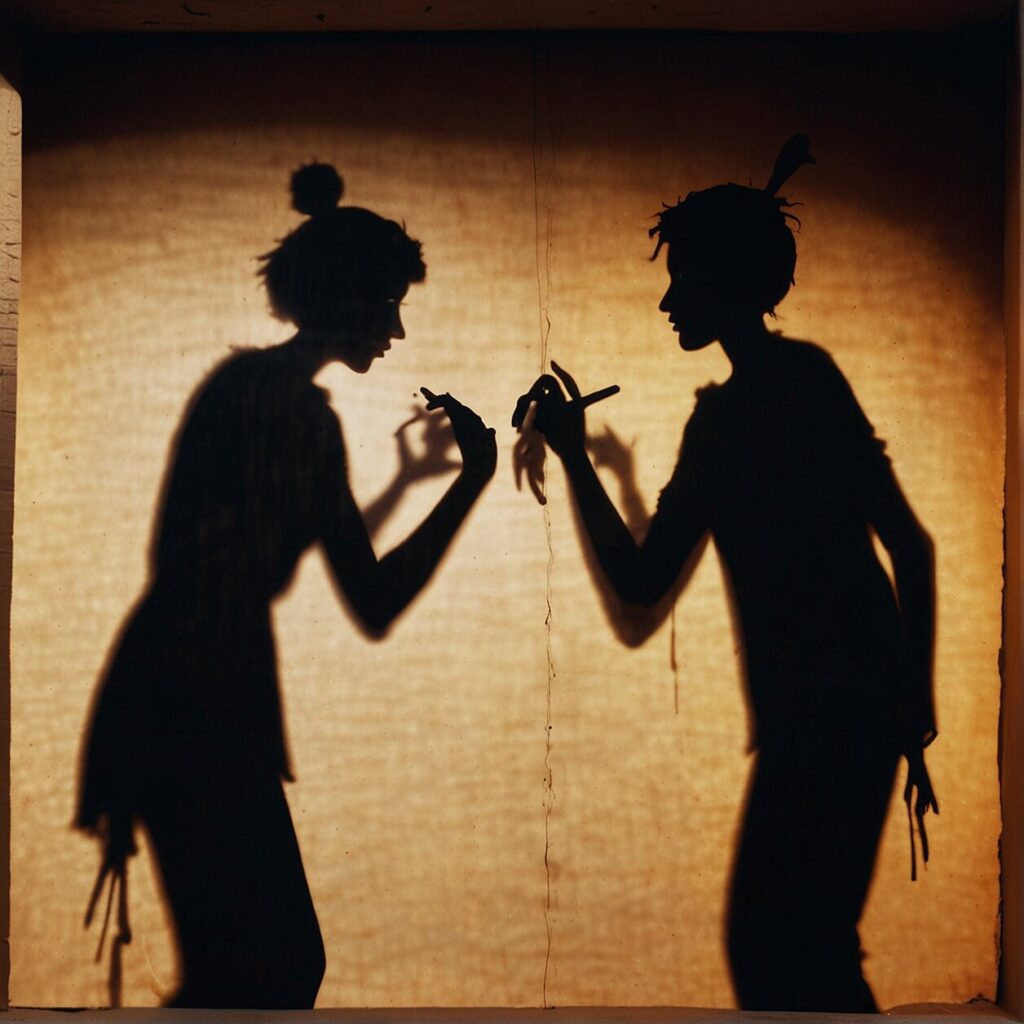Unveiling the Shadow Puppet Theater in Bali
Embarking on a journey into the enchanting world of Wayang Kulit, a form of shadow puppet theater, is like opening a magical book of Balinese culture and tradition. Dating back over a thousand years, this ancient art form offers an intriguing window into Bali’s rich history, providing a captivating fusion of mythology, morality, and melodrama that has endured the test of time. Its unique blend of storytelling and visual artistry has not only kept audiences rapt for centuries but has also secured it a prestigious place on UNESCO’s Intangible Cultural Heritage list.
“Wayang Kulit is not just a performing art; it’s an integral part of Balinese culture, reflecting the island’s rich tapestry of faith, values, and history.”
Steeped in symbolism, each Wayang Kulit performance serves as a mirror to the Balinese worldview, depicting the eternal struggle between good and evil, heavenly values and worldly desires, right and wrong. This meticulous work of artistry involves the creation and animation of highly detailed leather puppets in front of a simple, fabric screen. Illuminated from behind, the puppets cast shadows on the screen, bringing the stories and myths to life in a realm of silhouettes.
Let’s take you behind the scenes of this captivating art form to begin understanding and appreciating the intricate aspects that make Wayang Kulit truly special:
- The Puppets: Each puppet, painstakingly crafted from buffalo hide and mounted on bamboo sticks, is a work of art replete with intricate carvings and elaborate color schemes. Their form and design are filled with symbolic meanings that inform their roles within the narrative.
- The Puppet Masters: Known as Dalangs, these puppet masters are more than just performers. They are revered storytellers, cultural educators, and spiritual mediators, commanding respect and adoration from their audience.
- The Music: The accompanying Gamelan orchestra isn’t just for ambiance. The rhythm and tone it provides help narrate the flow of the story, emphasizing emotional transitions and adding another layer of depth to the narrative.
Through this article, let us immerse you more deeply in the world of Wayang Kulit, revealing the layers and complexities of this ancient performing art that continues to embody and preserve the essence of Balinese identity and spiritual life.
Unearthing the Roots: The Ancient History of Wayang Kulit in Bali
Delving into the rich tapestry of Balinese culture, you might find yourself fascinated by the ancient tradition of shadow puppet theater, or Wayang Kulit. With its roots firmly planted in a history smeared with mystery and debate, this traditional art form might seem to be stemming from belief systems as varied as Hinduism, Buddhism, and even folk religions).
Wayang Kulit, as we know today, is often considered a Javanese puppet performance born out of Affinity with Hindu-Buddhist principles. These principles reflect on the deeper ideologies of dharma and karma, often narrating stories about the pursuit of righteousness and the consequential nature of our actions. Alongside, elements of Javanese mysticism were woven into the artform, adding an intricate layer of philosophy and symbolism.
Despite its possible Indian origins, Wayang Kulit evolved and adapted magnificently with the local Balinese culture. Drawing from various literary sources, including Indian epics like Ramayana and Mahabharata, this art form also looked to local resources for inspiration. This resulted in the adaptation of narratives surrounding the East Javanese Prince Panji cycle and later, Muslim stories.
Considered the progenitor of the entire Wayang family, the Wayang Kulit has provided the aesthetics, the characterization, and indeed, the norms for all of Javanese classical theatre. It is this versatility, coupled with historical fascination, that has led Wayang Kulit to be so popular not just within Indonesia, but beyond its shores as well.

Symbols of Shadows: The Rich Iconography of Wayang Kulit
If you’ve heard of shadow puppetry, chances are you’re familiar with its hauntingly dark yet captivating silhouettes. In Bali’s Wayang Kulit, every shadow depicts an intricate tale woven delicately over generations. Let’s dive deeper into the captivating narratives of these characterful shadows.
Much to their wonder, observers of Wayang Kulit discover a vivid realm shaded through the interplay of light and darkness. The puppets, traditionally opaque, come alive on their illuminated screen as defining dark figures, their detail and mystery embellished by alignments of lace-like perforations, each deliberate and symbolic, shedding nuanced secrets on the plots they represent.
Wayang Kulit is a testament to the intriguing intersection of art and spirituality, taking roots from Javanese mysticism. The characters, representing different aspects of human nature, act as conduits conveying subtle teachings of the perpetual struggle between good and evil. Notably, it’s used by mystics as a spiritually redemptive device, amplifying its cultural significance.
Such puppets are more than mere characters on a screen. They bear a broader responsibility, symbolising various facets of societal norms and mental propensities. The characteristic differences of each puppet, be it in size, color, or other detailed distinctions, reflect the varying social status and psychological traits of the characters they embody – each carving displaying their own part in the drama or comedy of life.
The shadows in Wayang Kulit are far more than entertaining figures. They serve as the veil between the physical and spiritual worlds, linking human narratives with universal symbols of the gods, demi-gods, demons, and kings. It is through these shadows we explore hidden realms of our consciousness, unmasking subtle lessons eager to be perceived.
Thus, a mere silhouette in Bali’s Wayang Kulit is but a gateway into a culturally rich, spiritually enlightening narrative – a reflection of human life, society, and beyond.
Beyond the Shadows: Moral Messages in Wayang Kulit Stories
Lurking in the shadows of the Wayang Kulit are epic narratives filled with gods, demi-gods, demons, and kings. The ancient art form is not just an entertaining spectacle to behold, but its purpose extends to being a spiritual narration and a teaching tool. It’s amazing how an illuminated screen and shadow puppets can convey profound life lessons in an them. These narratives are enveloped in the teachings of enlightenment, acting as a moral compass for the viewers and leaving them spellbound with its allegorical storytelling.
The puppeteers, known as Dalang, play a vital role in Wayang Kulit. They aren’t merely performers pulling the strings of the puppets. These Dalangs are spiritual guides who manipulate the shadows, giving life to the figures while conveying deeper meanings and teachings. In their seasoned hands, the puppets yield stories which enchant the audience and impart vital life lessons.
Imbued with Javanese mysticism, the philosophy and symbolism within Wayang Kulit are profound and multifaceted. The use of shadow in Wayang Kulit is not merely a theatrical device, but a metaphoric veil between the physical and spiritual worlds, bringing intangible concepts and teachings into a format that’s easily understood by all. Wayang Kulit, in its heart, is a philosophy—an ideology of life portrayed through the artistry of shadows.

Staying True: The Preservation of Traditional Balinese Shadow Puppetry
Despite the fact that Wayang Kulit has long since stepped into the realm of ancient art, it has managed to survive the winds of change to the present day. With an unyielding devotion to preserving this time-honored tradition, Balinese communities have been instrumental in propagating this artform to their younger generations. Yet, the real magic lies in the profound lesson it teaches – honoring a heritage that remains true to ancient lore and values.
We live in an era marked by rapid digital advancements and pop culture influences, but the charm of Wayang Kulit persists, alive and thriving in Bali. This resilience is in large part due to the efforts of local puppet masters, or dalang, who continue to dedicate their lives in service of this art.
The dalang, as custodians of culture, play a vital role in storytelling, utilizing the unique attributes of shadow puppetry to unfold or recreate popular epics and local folklore. They have been pivotal in giving this ancient art a contemporary relevance while keeping its authenticity and spiritual essence intact.
Beyond performances, Wayang Kulit’s continuing significance in modern times is also evident in how it is used as a medium of education. The artform is employed in imparting moral values and conceptions of virtue through storytelling to children and adolescents. This nostalgic puppet play has an appealing way of teaching, where the wisdom of ancient visionaries meets the curiosity of young minds.
Moreover, workshops and classes focusing on the craft behind Wayang Kulit – right from puppet making to performance aspects are increasingly gaining popularity. This has opened a gateway to not just preserve, but also progressively evolve this heritage, allowing the continual flow of artistic expression and shared communal interactions.
Indeed, the vibrant lifeblood of Wayang Kulit offers a captivating way of understanding a culture that remains hooked to its roots, resolute in its values, and artistic in its expression. Truly, the survival and strengthening of Wayang Kulit is a testament to the Balinese spirit of upholding tradition amidst the tide of time.
Experience the Magic: How to Enjoy Wayang Kulit Performances in Bali
As you continue your journey through the rich cultural heritage of Bali, it’s an almost sublime experience to witness a Wayang Kulit performance. With its roots deeply embedded in Javanese Hindu-Buddhist ideologies, this ancient form of shadow puppetry is the heart and soul of many other theatre forms in Java and Bali. Held in high esteem throughout Asia, Wayang Kulit remains an enchanting testament to Bali’s enduring traditions.
Renowned spaces like the Sultans Palace of Yogyakarta and Keraton Solo in Indonesia provide the perfect backdrop to soak in the mystique of the Wayang Kulit. Traditional performances allow spectators to seat on the shadow side of the projection screen, enabling a unique and immersive viewing experience. Undoubtedly, the essence of the shadow theatre comes alive in the dim, flickering light, as the vividly designed shadow puppets weave a captivating, narrative tapestry.
The vibrant gamelan orchestras enhance the haunting allure of these performances, their resonating notes underlining the triumphs, despairs, and emotional nuances of the unfolding tales. Indeed, the music of Wayang Kulit is a symphony of moods, creating a mystical atmosphere that engulfs both the performers and the audience.
For a more hands-on experience, why not visit the Village of Kepuhsari in the Wonogiri Regency, Central Java? Here, you can observe and learn the intricate process of creating Wayang Kulit puppets, a meticulous craft that spans generations. By the end of your journey, you’ll come away with not only a better understanding of Wayang Kulit but also a renewed appreciation for the dedication to tradition that drives Balinese culture.
Apart from being a mesmerizing form of entertainment, Wayang Kulit performances are also rooted in community practices. Associated with selametan communal meals and various rituals, they indeed serve as essential cultural landmarks. So next time you’re in Bali, dare to venture beyond the tourist trails – you’ll find magic lurking in the shadows!
FAQ’S
Let’s dive a bit deeper and demystify the captivating world of Wayang Kulit. In this section, we’ll answer some frequently asked questions surrounding this ancient art form. We’ll journey through the fascinating landscapes of Bali, as we explore the wonders of Shadow Puppet Theater, the esteemed puppet masters, the significance of this tradition in Balinese culture, and its vibrant presence in festivals and education. Ready to understand Wayang Kulit a little more? Let’s get started.
Where can I experience a Wayang Kulit performance in Bali?
Grab the opportunity to witness the vibrancy and depth of the Wayang Kulit puppetry at the Sultans Palace of Yogyakarta and Keraton Solo in Central Java, Indonesia. These storied venues come alive with the dramatic shadows cast by intricately carved leather puppets, unfolding timeless Balinese tales before your eyes.
For a truly remarkable immersion into Wayang Kulit, head to the village of Kepuhsari in the Wonogiri Regency. This unique location not only offers stellar performances, but also provides an intimate, firsthand observation of the meticulous process of carving and creating Wayang Kulit puppets – the very heart of this exquisite art form. As you traverse this quaint village, you’ll be enveloped in the rhythm and pulse of a rich, enduring tradition, reverberating with the diligent work of puppet-makers.
For a truly immersive experience, try coordinating your visit with the selametan communal meals and associated rituals. Each aspect of these events, from the communal feasting to the highlighted performances, adds a new layer of depth and understanding to the Wayang Kulit experience.
Additionally, the Wayang Kulit performance by Ki Purbo Asmoro, presented by Asia Society in 2012, remains a momentous benchmark in the global celebration of this ancient Balinese art. If you’re unable to travel to Bali, digital platforms often broadcast such sterling performances so you can glimpse this shadow theatre from anywhere in the world.
Who are the traditional puppet masters in Balinese culture?
In the enchanting world of Balinese Wayang Kulit, the puppeteer holds the seat of honor and reverence. Known as the ‘dalang’, or commonly referred to as the ‘Mastermind’, these skillful artists are far more than mere performers. They play a multifaceted role in the ceremony.
A dalang is not just a puppeteer; he is a spiritual guide, a storyteller, a teacher. Utilizing the carefully crafted puppets, they convey profound teachings and deeper meanings via the colorful shadows thrown on the screen. The puppet characters, each representing different aspects of human nature, good and evil, are manipulated by the dalang to depict tales loaded with symbolic meaning.
The dalang’s work is intricate and physically demanding. He operates the puppet’s head-turning rod, skillfully playing various characters, all while being shrouded under a batik sarong. The dalang also commands the gamelan orchestra, guiding the rhythm and pace of the performance. The true artistry of a dalang is reflected in how effectively he can immerse viewers in the ebb and flow of the epic narratives, promoting a strong understanding of Hindu-Buddhist principles of dharma and karma.
By engaging with the highs and lows of the drama, attendees learn profound lessons about life, morality, and spirituality. Thus, wayang kulit performances are not merely a form of entertainment in Balinese culture, they’re a bridge between the tangible and intangible realms, a spiritual journey navigated by the dalang. Just as in life, the struggles between good and evil continue on the timeless stage of the Wayang Kulit.
What is the significance of the Shadow Puppet Theater in Bali?
Shadow Puppet Theater, or Wayang Kulit, holds a profound significance in Balinese culture. From its underlying spiritual connotations to its immense influence on traditional and contemporary arts, Wayang Kulit is more than just a performance; it’s an encapsulation of cultural wisdom and historical heritage.
In essence, Wayang Kulit serves as an extraordinary blend of storytelling, visual art, music, and spiritual teaching. The puppeteers, often revered as spiritual guides, convey intricate folk tales drawn from Indian epics such as the Ramayana or Mahabharata, local Indonesian tales, as well as teachings on moral values and life philosophies. These stories carry deeper, symbolic meanings, meant to impart wisdom about human nature and life’s complexities.
The art form has also been instrumental in shaping other theater forms in both Java and Bali, such as Wayang Klitik and Wayang Golek, further emphasizing its significance. Moreover, with its recognition as a Masterpiece of Oral and Intangible Heritage by UNESCO, Wayang Kulit puppetry undeniably holds a crucial role in preserving and promoting Indonesian heritage globally.
So, when sitting under the starlit skies of Bali, watching these shadowy figures dance on the screen, you’re not just being entertained. You’re also partaking in an ancient ritual, a celebration of traditional wisdom and cultural heritage, infused with the profound spiritual influences of Balinese society.
Are there any festivals in Bali that feature Wayang Kulit?
Without a doubt, Bali’s vibrant festival calendar offers numerous opportunities to experience Wayang Kulit in its cultural heartland. Balinese Hindu ceremonies, known locally as ‘odalan’, often include Wayang Kulit performances as part of their spiritual ambience, adding a further dimension of intrigue and fascination.
One of the biggest celebrations featuring Wayang Kulit is ‘Galungan’. This significant festivity commemorates the triumph of Dharma over Adharma, mirroring the epic tales depicted in Wayang Kulit stories. Puppet masters, or ‘dalang’, take centre stage with their crafts, mesmerizing locals and visitors alike with delicate puppet movements, compelling storytelling and hypnotic, rhythmic sounds.
Another lesser-known but equally meaningful event is ‘Tumpek Wayang’, a sacred day dedicated to Sang Hyang Iswara, the lord of puppeteers. On this day, offerings are made to Wayang Kulit puppets, making it an ideal time for puppet enthusiasts to immerse themselves in the rich tradition of this ancient art form.
It is worth noting that these events, along with others like ‘Nyepi’, ‘Purnama’, or ‘Tilem’, are not solely about watching a performance, but about experiencing the integral role of Wayang Kulit in Balinese community life and spirituality. Mark your calendar, plan a visit, and get ready to dive deep into the fascinating world of shadow theatre – a unique experience that awaits you in Bali.
How is Wayang Kulit used in Balinese education?
Imagine attending a class where instead of textbooks, the teacher uses shadow puppetry to impart wisdom. Yes, the Wayang Kulit, with its enchanting shadows and engrossing narratives, is indeed a key educational tool in Balinese society.
Let’s delve a little deeper into how it functions.
Puppeteers, or ‘Dalang’, are esteemed not only as skilled artists but also as educators in Bali. They use their masterful puppetry to communicate complex concepts and teachings in the form of captivating stories. Through tales enveloped in Hindu-Buddhist principles of dharma and karma, they guide their audience towards moral and ethical choices, while tracing the eternal cycle of cause and effect.
These performances often extend beyond entertainment into moral education, with the ‘Dalang’ using the subtle art form to impart life lessons and ethical values. Children actively participate in these performances, engaging with the timeless narratives that address everyday situations, philosophical inquiries, and social concerns. This interactive aspect fosters a deep understanding of the content and encourages a lively discussion.
Beyond shadow puppets, the music accompanying Wayang Kulit performances is an integral part of the learning process too. It sets the mood and tone of the story, helping to drive home the thematic implications and metaphysical lessons. Through this, students learn to appreciate the synergy between narrative, sound, and imagery, which is an essential part of artistic understanding.
All in all, Wayang Kulit becomes a unique conduit for holistic learning in Bali – making education an engaging, unforgettable, and fun process, that goes beyond the walls of conventional classrooms.







